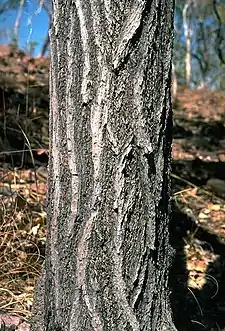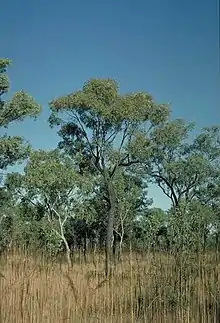Eucalyptus jensenii
Eucalyptus jensenii, commonly known as Wandi ironbark,[3] is a species of tree that is endemic to northern Australia. It has hard, coarse black "ironbark", egg-shaped to lance-shaped adult leaves, flower buds in groups of seven, creamy white flowers and barrel-shaped to conical fruit.


| Wandi ironbark | |
|---|---|
 | |
| Eucalyptus jensenii at the Gibb River Station | |
| Scientific classification | |
| Kingdom: | Plantae |
| Clade: | Tracheophytes |
| Clade: | Angiosperms |
| Clade: | Eudicots |
| Clade: | Rosids |
| Order: | Myrtales |
| Family: | Myrtaceae |
| Genus: | Eucalyptus |
| Species: | E. jensenii |
| Binomial name | |
| Eucalyptus jensenii | |
| Synonyms[2] | |
| |
Description
Eucalyptus jensenii is a tree that typically grows to a height of 3–12 m (9.8–39.4 ft) and forms a lignotuber. It has hard, rough, coarse black "ironbark" on the trunk and larger branches. Young plants and coppice regrowth have dull greyish green, egg-shaped to elliptic leaves 38–65 mm (1.5–2.6 in) long and 20–30 mm (0.79–1.18 in) wide. Adult leaves are the same shade of dull green or greyish green on both sides, egg-shaped to lance-shaped, 43–115 mm (1.7–4.5 in) long and 7–30 mm (0.28–1.18 in) wide on a petiole 3–20 mm (0.12–0.79 in) long. The flower buds are arranged mostly on the ends of branchlets on a branching peduncle 2–8 mm (0.079–0.315 in) long. Each branch of the peduncle has seven buds, each bud on a pedicel 2–8 mm (0.079–0.315 in) long. Mature buds are pear-shaped to oval, 3–4 mm (0.12–0.16 in) long and 2–3 mm (0.079–0.118 in) wide with a conical operculum. Flowering occurs from January to May and the flowers are creamy white. The fruit is a woody, barrel-shaped to conical capsule 3–5 mm (0.12–0.20 in) long and wide with the valves near rim level.[3][4][5]
Taxonomy and naming
Eucalyptus jensenii was first formally described in 1922 by Joseph Maiden from a specimen collected near Wandi by Harald Ingemann Jensen and the description was published in Maiden's book A Critical Revision of the Genus Eucalyptus. Wandi is an old gold-mining camp near Pine Creek in the Northern Territory.[6][7] The specific epithet honours the collector of the type specimen.[3]
Distribution and habitat
Wandi ironbark grows in open forest and woodland, usually on slopes and tablelands but sometimes on flats and near swamps. It occurs in the Kimberley region and Dampier Peninsula in Western Australia and in northern parts of the northern Territory, including on Groote Eylandt.[3][4]
See also
References
- Fensham, R.; Laffineur, B.; Collingwood, T. (5 June 2019). "Eucalyptus jensenii". IUCN Red List of Threatened Species. 2019: e.T133375444A133375446. doi:10.2305/IUCN.UK.2019-3.RLTS.T133375444A133375446.en. Retrieved 22 June 2023.
- "Eucalyptus jensenii". Australian Plant Census. Retrieved 1 August 2019.
- "Eucalyptus jensenii". Euclid: Centre for Australian National Biodiversity Research. Retrieved 1 June 2020.
- Chippendale, George M. "Eucalyptus jensenii". Flora of Australia. Australian Biological Resources Study, Department of the Environment and Energy, Canberra. Retrieved 1 August 2019.
- "Eucalyptus jensenii". FloraBase. Western Australian Government Department of Biodiversity, Conservation and Attractions.
- "Eucalyptus jensenii". APNI. Retrieved 1 August 2019.
- Maiden, Joseph (1922). A Critical Revision of the Genus Eucalyptus. Sydney: New South Wales Government Printer. pp. 255–256. Retrieved 1 August 2019.
